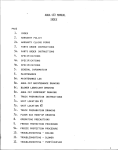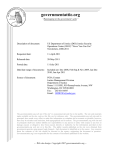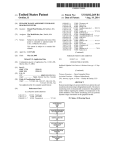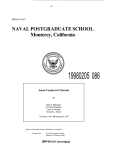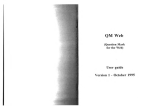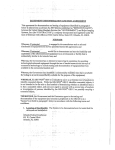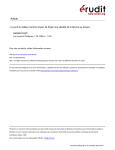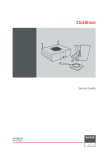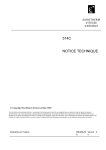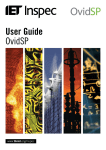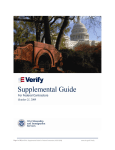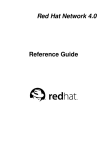Download Lozano v. City of Hazleton - Attachment to Defendants` Motion to
Transcript
EXHIBIT B
--
MEMORANDUM
November 10,2006
TO:
Business License Division
FROM:
Clay Phillips, City
SUBJECT:
Ordimce 2006-38 R
I.
Interpretation of l6(E)-l(a) (Prospective Onlyl:
This Ordinance shall be applied only to leases and rental agreemenl entered into
after the effective date of the Ordinance. The language in Section 16E-l(a) which
defines harboring to mean "to let, lease or rent a dwelling unit" to an illegal alien shall
mean to create a new tenancy by either entering into a new lease or renewing an existing
lease. A dwelling unit owner shall not be deemed to "suffer or permit the occupancy of a
dwelling unit" by an illegal alien where such occupancy occurs as a result of a lease or
rentaI agreement entered into prior to the effective date of this ordinance. The renewal of
month-to-month teases or other types of tenancy which automatically renew absent notice
by either Party will not be considered as entering into a new lease or renewing a lease.
II.
Su@ Harbor
Dwelfing unit owners are encouraged to utilize the "safe harbor" of Section 16E-2(i).
Under this section, the dwelling unit owner can ask the City to contact the federal
government and verify the la*
immigration status of the potential tenant using the
Systemic Alien Verificafion for Entitlements (SAVE) as described in Attachment 1 or
other equivalent system of the federat govenunent. There can be no violation of the
ordinance where the dwelling unit owner has utilized the provisions of Section 16E-2(i)
and confirmed that the potential tenant i s lawfully present in the United States. If the
dwelling unit owner does not verify prior to leasing, the dwelling unit owner may be at
risk under the ordinance.
111.
Investigating CumpIaints:
The City shall require ail complaints initiated under Section 16E-2(a) to be signed by
the complainant, The City shall review the complaint and only if there are reasonable
grounds for fkther inquiry mill the City proceed with its investigation. In making this
determination the City shall be specifically mindful of the requirement of Section 16E-
FWO4 (Rev. 7/03)
,
Memorandum Re Ordinance 2006-38 R
November 9,2006
Page 2
2(b) that a complaint which alleges a violation solely or primarily on the basis of national
origin, ethnicity, or race shall be deemed invalid,
N.
VeriJ;cationof Lawful Immigration Status
In determining that there are reasonable grounds to verify an individual's lawful
immigration status, the City shall contact the dweilii unit owner of the dwelling unit to
obtain identity data. The data requested will be that required by the federal verification
system (e.g., Systematic Alien Verification for Entitlements (SAVE) as described in
Attachment 1.) The City shall take no M e r action on the complaint until a response
concerning the immigration status is received from the federal government. If for some
reason, the federal government is unable to determine concfusiveIy whether an alien is
unlawfUlIy present in the United States, the City shall take no fufther action and the
laadIord shall not be deemed to be in violation of the ordinance. At no point shall any
City official attempt to make an independent determination of any alien's status, without
federal verification. The City shall not apply this Ordinance in any manner that e a t e s
federal immigration law, paaicularly with respect to aliens who are in the process of
obtaining legai status.
V.
Correction of Yio6ation
Within 10 days after notice by the City that one of its dwelling units is being occupied
by a tenant who is not lawfully present in the United States, the dwelling unit owner must
take one of the following ations:
Upon obtaining additional data or information £iom the tenant relating to the
(I)
tenant's immigration status, the dweEling unit owner may ask the City to resubmit the
tenant's name to the federal verification system using the additional information
provided. Upon receipt of this additional data the City shdl resubmit the tenant's
name through the federal verification system. While this second inquiry is pending
the 10 day period set forth in Section 16E-2(d) shall not be deemed to have expired
and City shall take no M e r action until a response concerning the immigration
status is received from the federal government.
The dwelling unit owner notifies the City that the tenancy of the person who
(2)
was not iawfidly present in the United States has been terminated. In such a situation
the complaint shall be terminated and no fkrther action taken.
The dwelling unit owner notifies the City that it has commenced steps under
state or federal law to end the tenancy of the person who is not lawfUlly present in the
United States. While the dwelling unit owner is diligently pursuing such remedies the
(3)
Memorandum Re Ordinance 2006-38 R
November 9,2006
Page 3
lOday period set forth in Section 16E-2(d)shall not be deemed to have expired. The
dwelling unit owner should be aware that this orditlance does not change state or
federal law, nor does it grant the landowner any additional rights or remedies
regarding termination of tenancies which do not otherwise exist.
If a situation arises where the dwelling unit owner is not able to correct the
violation and the10 days has expired, pursuant to Section 16E-2(d), the dwelling unit
owner loses its business license for the affected dwelling unit only. The fact that the
dwelling unit owner has no business license shall not terminate the tenancy in that
unit. However, pursuant to Section 16E-2(e), while its business license is suspended,
the dwelling unit owner will be prohibited from receiving any payment or rent ffom
the tenant of that unit.
2
VI.
Serbmiftalto State and Federal E ~ f o r c e ~ eAgencies
nt
The City shall only subnit Somation to state or federal enforcement agencies under
the ordinance, including-submittalsunder Section 16E-2(g), pursuant to the authority of 8
U.S.C. 9 1373, atld shall not submit information in any manner which violates Section
1373.
EXHIBIT B-I
U.S. Immigration & Naturalization Service
Professionalism Through a Technologically Empowered Worh$orce.
EXHIBIT B-1
Systematic Alien Verificationfor Entitlements
(SAVE) Program User Manual
Table of Contents
1.
2
3
4
Introduction ....................................................................................................
..............1-1
1 .1 . Purpose and Scope.............................................................................................. 1-1
.
SAVE Program ....................................................................................................................2-1
2 I.
2.2.
2.3.
2.4.
2.5.
2.6.
Background..........................................................................................................
2-1
SAVE Legal Basis ...........................................................................................2 - 1
Program Components ........................................................................................2 - 3
SAVE Program Administration.......................................................................... 2-6
General Verification Procedures .......................................................................2 - 7
Legal Protection and Safeguards ........................................................................2-7
3.1 .
3.2.
3.3.
.3.4.
3.5.
3.6.
3.7.
3.8.
3.9.
Background........................................................................................................ 3 - 1
General Verification Procedures ....................................................................... 3 - 1
Required Documentation................................................................................... 3 - 2
Immediate Secondary Verification ...................................................................3 - 3
ASVI Access Methods .......................................................................................3-4
understanding ASVI Output Data ..................:..............................................
3 - 5
General Information ...........................................................................................
3-9
ASVI Enrollment Process.................................................................................3 - 9
ASVI Billing Process ......................................................................................3-10
.
.
Primary Verification Procedures ................................................................................... 3-1
Secondary Verification Procedures .............................................................................. 4-1
4.1 . Background........................................................................................................4 - 1
4.2. Initiating Secondary Verification ....... .,..............................................................4-1
4.3. Obtaining Secondary Verification ..................................................................... 4 - 2
4.4. Attachments ........................................................................................................ 4-2
4.5. Completing the document^ Verification Request .............................................. 4 - 3
4.6. Completing the Document verification Request Supplement ...........................4-5
4.7. Mailing Document Verification Requests .....................................................4 - 5
4 .'8. Obtaining Copies of the Document Verification Requests and Supplement ..... 4-6
4.9. Document Verification Request and Supplement Responses ............................ 4-6
4.1 0 . Understanding the INS Response ..................................................................... 4 - 7
4.1 1 . Delayed Replies ................................................................................................4-11
4.1 2 . INS Record Keeping........................................................................................ -4-12
i
September 2000
Systematic Alien VeriJicationfor Entitlements
(SA VE) Program User Manual
Appendix A:
Appendix 6:
Appendix C:
Appendix D:
Appendix E:
Appendix F:
Appendix G:
Appendix H:
.....................................................................
............................................................................................................
........................................................................................
Sample Immigration Documents
Glossary
Hispanic Names ................................................................................................
INS Office Locations
INS Office Addresses .......................................................................................
Forms G845S, G845 and Supplement ..........................................................
INS Records Systems
Questions and Answers
....................................................................................
..................................................................................
A-I
B-I
C-I
D-I
E-I
F-I
G-I
H-1
11
September 2000
Systematic Alien VeriJicationfor Entitlements
(SA VE) Program User Manual
I.Introduction
Section 121 of the Immigration Reform and Control Act of 1986 (IRCA), as amended by
the Personal Responsibility and Work Opportunity Reconciliation Act of 1996
(PRWOM), requires verification of citizenship and immigration status of applicants
applying for many federal, state, and local public benefits. Each applicant for benefits
must declare in writing whether or not they are a citizen or national of the United States,
and if not, that they are in a satisfactory immigration status.
The Illegal Immigration Reform and Immigrant Responsibility Act of 1996 requires the
Immigration and Naturalization Service (INS) to respond to inquiries by federal, state,
and local benefit issuing agencies and institutions seeking to verify or determine the
citizenship or immigration status of any individuals within the jurisdiction of the agency
for any lawful purpose.
If an applicant or recipient for any of the benefits listed in IRCA, as amended, is not a
U.S. citizen or national, they must provide the benefit provider with documentation from
the INS that contains their Alien Registration Number (A-Number), or verbally provide
information from such documentation, that provides reasonable evidence of his or her
current immigration status. The INS verifies'the immigration status through automated
and/or manual methods. The process of verification is known as the Systematic Alien
Verification for Entitlements (SAVE) Program.
The INS is currently using the SAVE automated and manual verification processes to
provide federal, state, and local benefit issuing agencies and institutions with information
which will assist them in determining an individual's eligibility under Title IV of
PRWORA.
1.1.
Purpose and Scope
This manual describes the SAVE Program, including its legal basis, automated and
manual verification processes, and administrative procedures. Chapter 2 gives general
program guidelines and information on administration, and is ,designed for managers and
supervisors at benefit issuing agencies and institutions. Chapter 3 provides a detailed
overview of the primary verification process. Chapter 4 provides detailed instructions for
performing secondary verification. This manual serves as both a training and reference
guide for benefit providers and their managers.
1-1
September 2000
Systematic Alien Verz~kation
for Entitlements
(SA VE) Program User Manual
{Blank}
1-2
September 2000
Systematic Alien VeriJicationfor Entitlements
(SA VE) Program User Manual
I
!
2. SAVE Program
This chapter of the Systematic Alien Verification for Entitlements (SAVE) Program
Manual describes the program and explains its legal basis and measures to safeguard the
rights of naturalized citizens and non-citizens.
Any questions or comments regarding this chapter of the manual should be directed to the
Immigration and Naturalization Service (INS) SAVE Program at (202) 514-23 17.
2.I .
Background
The SAVE Program is an intergovernmental information-sharing initiative designed to
aid benefit providers in verifylng an applicant's immigration status, thereby ensuring that
only entitled applicants receive public benefits. The INS SAVE Program provides an
information service for benefit issuing agencies and institutions. The INS does not make
determinations on any applicant's eligibility for a specific benefit.
The SAVE Program has been in operation since 1987. Significant costs in claims for unentitled non-citizens have been avoided through benefit issuing agencies and institutions'
participation in the SAVE Program.
2.2.
SA VE Legal Basis
In 1986, Congress passed the Immigration Reform and Control Act of 1986 (IRCA),
which required INS to establish a system for verifylng the immigration status of noncitizen applicants for, or recipients of, certain types of federally funded benefits, and to
make the system available to federal, state, and local benefit issuing agencies and
institutions that administer such benefits. The IRCA and the Personal Responsibility and
Work Opportunity Reconciliation Act of 1996 (PRWORA), mandates the following
programs and overseeing agencies to participate in the verification of an applicant's
immigration status: the Temporary Assistance to Needy Families (TAW) Program, the
Medicaid Program, and certain Territorial Assistance Programs (U.S. Department of
Health and Human Services); the Unemployment Compensation Program (U.S.
Department of Labor); Title IV Educational Assistance Programs (U.S. Department of
Education); and certain Housing Assistance Programs (U.S. Department of Housing and
Urban Development).
2- 1
September 2000
Systematic Alien VeriJicationfor Entitlements
(SA VE) Program User Manual
The PRWORA created a very complex set of eligibility requirements that cannot be easily
summarized. These requirements continue to be regularly amended by Congress. The
PRWORA did not affirmatively make any person eligible for any benefit. Rather, it
placed a new set of limitations on non-citizen eligibility on top of any pre-existing
program requirements (some of which may have limited non-citizen eligibility). With
certain exceptions, PRWORA made non-citizens who are not qualified aliens ineligible
for federal public benefits, and aliens who are not qualified aliens or lawful nonimmigrants or aliens paroled into the United States under Section 212(d)(5) of the INA
for less than one year ineligible for state or local public benefits. There are also
limitations on the eligibility of qualified aliens for benefits, again with exceptions. The
PRWORA, as amended by the Illegal Immigration Reform and Immigrant Responsibility
Act of 1996 (IIRIRA) and the Balanced Budget Act of 1997 (BBA), defines a "qualified
alien" as:
An alien who is lawfully admitted for permanent residence under the Immigration and
Nationality Act (INA)
An alien who is granted asylum under Section 208 of the INA
A refugee who is admitted to the United States under Section 207 of the INA
An alien who is paroled into the United States under Section 212(d)(5) of the INA for
a period of at least one year
An alien whose deportation is being withheld under Section 2 4 3 0 of the INA (as in
effect prior to April 1, 1997) or whose removal has been withheld under Section
241(b)(3)
An alien who is granted conditional entry pursuant to Section 203(a)(7) of the INA as
in effect prior to April 1, 1980
An alien who is a CubadHaitian Entrant as defined by Section 501(e) of the Refugee
Education Assistance Act of 1980
Certain aliens who have been battered or subjected to extreme cruelty as defined in
USC Section 1641 (c)
The PRWORA restrictions do not apply to all federal, state, and locally funded activities
or programs; they apply only to non-exempted "federal public benefits" and "state and
local public benefits." Therefore, benefit providers should first determine whether the
particular program they administer is providing a "federal public benefit" or a "state and
local public benefit" for which Title IV of PRWORA or other applied laws require alien
eligibility. For example, emergency medical care and certain forms of disaster relief are
exempt, as are other key benefits. If an agency requires further assistance in determining
whether a specific benefit it administers is a federal, state, or local public benefit, it
should contact the overseeing federal, state, or local Government agency, as that agency
would be in the best position to make that determination.
2-2
September 2000
Systematic Alien Verificationfor Entitlements
(SA VE) Program User Manual
The PRWORA defines "federal public benefit" as:
Any grant, contract, loan, professional license, or commercial license provided by an
agency of the United States or by appropriated funds of the United States.
- AND Any retirement, welfare, disability, public or assisted housing, post-secondary
education, food assistance, unemployment benefit, or any other similar benefit for
which payments or assistance are provided to an individual, household, or family
eligibility unit by an agency of the United States or by appropriated funds of the
United States.
The PRWORA's definition of "state and local public benefityyparallels the definition of
federal public benefit, except that it substitutes "state or local government" for "the
United States." State or local public benefits do not include federal public benefits;
therefore, a benefit cannot meet both definitions. If a benefit qualifies as a "federal public
benefit," it is not a "state or local public benefit" regardless of whether state or local
funding is also involved.
The IIRIRA requires INS to respond to inquiries by federal, state, and local benefit
issuing agencies and institutions seeking to verify or determine the citizenship or
immigration status of any individual within the jurisdiction of the agency for any lawful
purpose. The INS is currently using the SAVE Program's automated and manual
verification processes to provide federal, state, and local benefit issuing agencies and
institutions with information which will assist them in determining an individual's
eligibility under Title IV of PRWORA.
2.3.
Program Components
As mandated by IRCA, INS developed an effective, secure, and cost effective method of
verification. The SAVE Program relies on the Alien Status Verification Index (ASVI)
database, which contains information on more than 60 million non-citizens. When
accessed by the user, ASVI responds within 3 to 5 seconds of the query. The ASVI
database is housed and maintained under contract with Lockheed Martin Integrated
Business Solutions (LMIBS).
2-3
September 2000
Systematic Alien VeriJcationfor Entitlements
(SAVE) Program User Manual
The automated process is known as the "primary verification." The following flow chart,
Figure 2-1 shows the Primary Verification Process.
,
Figure 2-1: Primary Verification Process
PRIMARY VERIFICATION PROCESS
Non-citizen submits
application to Benefit
Issuing Agency
PRIMARY VERIFICATION
SECONDARY VERIFICATION
Status Review and ASVI Query
Benefit Issuing Agency institutes
secondary verification process by
submitting completed Document
Verification Request, Form G-845,
with a photocopy of supporting
documentation or by submitting
additional information electronically
to appropriate INS field office for
thorough search of other INS
automated and manual data sources
INS either completes Form
G-845 or an electronic
response and replies to Benefit
Issuing Agency
I
I
II
YES
NO
I
In most cases, Benefit Issuing Agencies that use primary verification will query ASVI
before instituting secondary verification.
I
II
In addition, SAVE verification is available through secondary verification if the use of
ASVI is not cost-effective. The SAVE Program also requires participating benefit
issuing agencies and institutions to use secondary verification when directed by an ASVI
system message during primary verification, or when the primary check or initial
inspection of a non-citizen's immigration documentation reveals material discrepancies
2-4
September 2000
Systematic Alien VeriJicationfor Entitlements
(SAVE) Program User Manual
or when verification of a naturalized citizen is required. See Figure 2-2 for a flow chart
on the Secondary Verification Process.
Figure 2-2: Secondary Verification Process
SECONDARY VERIFICATION PROCESS
Benefit Issuing Agency institutes secondary verification process
by submitting completed Document Verification Request, Form
G-845, with a photocopy of supporting documentation or by
submitting additional information electronically to appropriate
INS field office for thorough search of other INS automated and
manual data sources
Determination as to Applicant's Eligibility
for Benefit
NO
YES
Agencies that do not access ASVI will proceed directly to the secondary verzjkation process.
2-5
September 2000
Systematic Alien Verzjkation for Entitlements
(SA VE) Program User Manual
2.4.
SA VE Program Administration
The SAVE Program is administered at the INS Headquarters Office in Washington, DC,
by the Office of Files and Forms Management, SAVE Program. User agencies and
institutions may contact INS SAVE Program staff at (202) 514-23 17. The Data Systems
Division of the INS Office of Information Resources Management has responsibility for
providing technical support to the SAVE Program. The SAVE Program also provides
policy and guidance relating to the seconday verification process to INS field offices.
The INS Headquarters Office of Field Operations, Regional and District Offices, and
Suboffices have operational responsibility for carrying out policy and guidance provided
by the SAVE Program. Figure 2-3 is the INS organization chart as it relates to the SAVE
Program.
Figure 2-3: INS SAVE Program Organizational Chart
INS Commissioner
I
Executive Associate
Commissioner for
- Coordination and liaison
with field Immigration
Status Verifiers (ISVs)
II
I
- Liaison with benefit
issuing agencies and
institutions
District Offices and
Suboffices
- Secondary.Verification
- Coordination and liaison
with counterparts in
benefit issuing agencies
and institutions
Executive Associate
Commissioner for
Management
b
Management
I
Information
Resources
Management
SAVE program
I
- Program resp'onsibility
- Program development
- Primary verification
I
Data Systems
Division
I - Primary database
policy and procedures
- Secondary verification
policy and procedures
-,Liaison with federal,
state, and local benefit
issuing agencies and
institutions
- Technical system
I
development and
maintenance
- Contracting Officer's
I
I
Technical
Representative (COTR)
I L
- Update of records
2-6
September 2000
Systematic Alien Verificationfor Entitlements
(SA VE) Program User Manual
Although IRCA, as amended by PRWORA, mandates only federal public benefit
programs to participate in SAVE, any federal, state, or local benefit issuing agency or
institution, or licensing issuing bureau that requires verification of a non-citizen's
immigration status may inquire about participation by contacting the INS SAVE Program
at (202) 5 14-2317.
2.5.
General Verification Procedures
At the time of application, all individuals applying for public benefits listed in IRCA and
PRWORA, are required to declare in writing, under penalty of perjury, whether they are a
United States citizen or a United States non-citizen national, or that they are in a
satisfactory immigration status. If an applicant claims to have a satisfactory immigration
status, they must present immigration documentation that the federal benefit provider is
required to verify with INS, or that the state and local benefit provider can opt to verify
with INS, via automated access to ASVI or through manual submission of a Document
Verification Request, or both.
Detailed instructions for the primary and secondary verification processes are located in
Chapters 3 and 4, respectively.
2.6.
Legal Protection and Safeguards
Determination
of Benefits
Award or denial of a benefit based on immigration status and the
establishment of a fair hearing process are the responsibilities of the
benefit issuing agency or institution. The benefit issuing agency or
institution will obtain INS verification of immigration status, and
determine whether or not the non-citizen is eligible for a benefit
according to its own regulations.
Fair Hearing
Each benefit issuing agency or institution will maintain its own fair
hearing and appeals process for individuals who have been denied
benefits. The INS will provide the appropriate immigration technical
consultation and witness support necessary to the agency or
institution during the fair hearing process on a prearranged and
approved basis. The INS should be consulted well before the hearing
is scheduled to resolve any problems, such as data discrepancies or
misunderstandings that might have led to the denial.
Nondiscrimination
Various Federal civil rights laws and regulations prohibit
discrimination by governmental and private entities on the basis of
race, color, national origin, gender, religion, age, and disability. Thus
in operating or participating in a federally assisted program and
implementing the requirements of the INA, as amended by
2-7
September 2000
Systematic Alien Verificationfor Entitlements
(SA VE) Program User Manual
PRWORA, including those described in this user's manual, a benefit
issuing agency or inititution should not, on the basis of race, color, or
national origin, directly or indirectly differentiate among persons in
the types of program services, aids, or benefits it provides or the
manner in which it provides them. For example, benefit providers
should treat all similarly situated individuals in the same manner, and
should not single out individuals who look or sound foreign for closer
scrutiny or require them to provide additional documentation of
citizenship or immigration status.
Certain data that is released during the verification process requires
Protection
Under Federal INS to comply with sections of the Privacy Act (5 U.S.C. 552a).
Consequently, INS will maintain a Record of Disclosure on all alien
Statutes
registration numbers checked through the verification process for legal
permanent residents (LPRs) and naturalized citizens. The following
data will be maintained regarding each query, and it will be disclosed
in accordance with the Privacy Act:
Alien registration number
Date and time of disclosure
Benefit issuing agency or institution requesting immigration status
verification
Non-citizen's immigration status at the time of inquiry
The INS will protect an individual's privacy to the maximum degree
possible, in accordance with the Immigration and Nationality Act and
any other applicable statutes.
If an immigration document does not contain an alien registration
number, INS will conduct computer checks against all available INS
data systems during manual verification to determine the holder's
immigration status. The INS will make a record of disclosure when all
the following conditions hold true:
It finds that an alien registration number exists for that applicant;
The document appears bona fide; and
The non-citizen's immigration status requires disclosure
accounting.
he records of disclosure created by checks made against ASVI and
other systems of records will be available to any person or agency in
accordance with federal statutes.
The verification processes maintain an audit trail which is used for
2-8
September 2000
Systematic Alien VeriJicationfor Entitlements
(SA VE) Program User Manual
purposes of identifying inordinate and extraordinary use of Alien
Registration Numbers. Examples of such suspicious activities include
non-existent Alien Registration Numbers and numbers checked
repeatedly fi-om multiple localities within a short period of time. This
information may be used by INS and other federal, state, and local law
enforcement entities for investigation of possible criminal activity, in
accordance with existing federal statutes. The ASVI audit trail will
not be used by INS for non-criminal, administrative enforcement of
immigration laws. Benefit issuing agencies or institutions that require
information from the audit trail should contact the INS SAVE
Program at (202) 514-23 17.
Safeguards
The INS, participating benefit issuing agencies and institutions, and
contractors shall protect the.individualYsrights to the fullest extent of
the law.
Immigration and Naturalization Service. The SAVE Program has
been implemented in a manner that provides for verification of
immigration status without regard to sex, color, race, religion, or
national origin of the individual involved. The INS stores information
in a secure area in order to safeguard its confidentiality. Data usage is
restricted to persons whose duties and responsibilities indicate a need
for its review.
Participating Benefit Issuing Agencies and Institutions.
Participating benefit issuing agencies and institutions shall provide a
non-citizen applicant with a reasonable opportunity to furnish
evidence of satisfactory immigration status. The benefit issuing
agency or institution using SAVE should make the determination for
itself whether benefits should be provided on an interim or temporary
basis to applicants pending completion of the SAVE processes,
applying any legal authority that may be relevant to that benefit. For
example, IRCA's statutory provisions regarding Medicaid,
unemployment compensation, and other Federal benefit programs
required to use SAVE generally prohibit benefit issuing agencies and
institutions determining eligibility for these benefits fi-om delaying,
denying, reducing, or terminating benefits pending SAVE verification.
Lockheed Martin Integrated Business Solutions (LMIBS)'. l he
database housed and maintained by LMIBS is a "read onlyy' system.
No update capability is available to the benefit providers. However, if
data discrepancies in ASVI are discovered during manual verification,
INS will update the database as necessary.
Safeguards
The LMIBS, under contract with INS, stores the database and provides
2-9
September 2000
Systematic Alien Verijicationfor Entitlements
(SA VE) Program User Manual
(continued)
access to authorized benefit issuing agencies and institutions using
proper security safeguards. This system avoids dissemination of
applicant information to unauthorized individuals or agencies.
2-10
September 2000
Systematic Alien VeriJcationfor Entitlements
(SA VE) Program User Manual
3. Primary Verification Procedures
This chapter of the SAVE Program manual provides instructions for primary verification.
It gives guidelines for evaluating non-citizen documentation, interpreting ASVI output,
and selecting cases for immediate manual verification when necessary.
Questions, comments, and changes regarding information in this section of the manual
should be directed to the INS SAVE Program at (202) 514-23 17.
3.1.
Background
SAVE Program participants will generally use the Alien Status Verification Index (ASVI)
database, which contains information on more than 60 million non-citizens for initial
automated status verification. This automated process is known as primary verification.
When accessed by the user, ASVI will respond within 3 to 5 seconds of the query.
Current users access the ASVI database, which is housed and maintained by Lockheed
Martin Integrated Business Solutions (LMIBS), with any one of six access methods.
Those methods of access include: 3270-terminal, Personal Computer, Point-of-Sale,
Touch-Tone Telephone, Electronic File Transfer, or Remote Job Entry. The touch-tone
telephone, point-of-sale, and electronic file transfer access methods are no longer
available to new users of the SAVE Program.
In addition, SAVE verification is available to benefit issuing agencies and institutions
through a manual verification process, known as secondary verification, when the use of
ASVI is not cost effective. Secondary verification is also required when primary
verification reveals material discrepancies or when the user is so directed by an ASVI
system message.
3.2.
General Verification Procedures
At the time of application, all individuals applying for the public benefit programs listed
in the Immigration Reform and Control ~ coft 1986 (IRCA), as amended by the Personal
Responsibility and Work Opportunity Reconciliation Act of 1996 (PRWORA), must
declare in writing, under penalty of perjury, that they are United States citizens or United
States non-citizen nationals and, if not, that they are in a satisfactory immigration status.
If an applicant is not a citizen or non-citizen national of the United States, they must
present immigration documentation that the benefit issuing agency or institution will
verify with INS, through the automated system or by submitting a Document Verification
Request, Form G-845, to INS.
3-1
September 2000
Systematic Alien Verificationfor Entitlements
(SAVE) Program User Manual
3.3.
Required Documentation
All non-citizens applying for public benefits must present immigration documentation, or
in some cases, verbally provide information from such documentation, that the benefit
issuing agency or institution determines is reasonable evidence indicating a satisfactory
immigration status. The document must be returned to the non-citizen by the reviewing
agency.
If an applicant presents an expired document or is unable to present any immigration
documentation evidencing their immigration status, refer the applicant to the local INS
Office to obtain documentation of their immigration status. In unusual cases involving
applicants who are hospitalized or medically disabled, or who can otherwise show good
cause for their inability to present documentation, and for whom securing such
documentation would constitute an undue hardship, if the applicant can provide other
identifyng documentation i.e., marriage records, court orders, etc., the benefit issuing
agency or institution may submit the Document Verification Request and, if applicable, a
copy of any expired INS document presented, to the local INS Office to verifl the
applicant's immigration status.
Section 264 of the Immigration and Nationality Act (INA), 8 U.S.C. 1304, states noncitizens 18 years of age or older in the United States must have immigration
documentation in their possession at all times. Non-citizens without documentation, such
as those who claim documents were lost or stolen, should be referre.d to the local INS
office (as shown in the U.S. Government listing of the telephone directory) to request
new documentation prior to the initiation of primary or manual verification procedures.
Most non-citizen applicants will present documentation that contains an Alien
Registration Number (A-Number). This number references an individual's non-citizen
file at INS. The A-Number contains seven, eight, or nine numerical digits preceded by
the letter A, e.g., A72 735 835. Each A-Number is unique in that it pertains to only one
person; even minors and infants who are not citizens or nationals of the United States are
assigned individual A-Numbers.
Immigration documentation includes but is not limited to the examples shown in
Appendix A of this manual. Except for the Arrival-Departure Record, Form 1-94>such
documents should show the A-Number of the bearer. Some documents have expiration
dates. These dates should be checked during the benefit issuing agency or institution's
visual examination of the documentation. Some forms have been released in several
editions and, therefore, valid documentation may not match the example exactly. The
examples in Appendix A represent those INS documents that are most commonly
presented and are not all inclusive. Appendix B-Glossary, defines terms related to
immigration status.
3-2
September 2000
Systematic Alien Verzjkationfor Entitlements
(SA VE) Program User Manual
A Form 1-94 with the following endorsement will have an A-Number annotated on it and
is an acceptable document as long as the expiration date has not passed: "Processedfor
1-53]. Temporay Evidence of Lawful Admission for Permanent Residence. Valid until
. Employment Authorized or Temporay Form 1-551, Admission for
permanent resident or (port) (date) verz3ed. " A non-citizen's passport may also contain
the endorsement above and will have an A-Number annotated on the passport.
Non-citizens also may present other pertinent documents, such as marriage records or
court orders, that indicate the identity or United States residency of the holder. Although
these documents may not serve as adequate proof of immigration status, they may prove
useful in the secondary verification process, when required.
Some INS documents do not contain a photograph of the bearer. When such
documentation is presented, INS strongly recommends that the benefit provider ask for a
document that includes a photograph, such as a driver's license or an employee badge. A
copy of this document need not be provided during the secondary verification process
because the purpose of requesting the document is to ensure that the benefit provider can
identify the non-citizen satisfactorily.
3.4.
Immediate Secondary Verification
Under most circumstances, an automated check of INS records through ASVI is the first
step in the verification process. However, the following circumstances require that the
benefit provider forego the use of ASVI and perform secondav verification immediately:
. A document appears to be counterfeit or altered. Characteristics of suspect
documentation include photograph substitution and ink discoloration.
A non-citizen presents unfamiliar INS documentation, or a document that indicates
immigration status, but does not contain an A-Number.
A non-citizen presents immigration documentation with an A-Number in the
60,000,000 or 80,000,000 series.
The non-citizen has no immigration documentation and is hospitalized, medically
disabled, or who can otherwise show good cause for their inability to present
documentation, and for whom securing such documentation would constitute an
undue hardship.
The non-citizen presents a foreign passport andlor Form 1-94 and the "Admission for
Permanent Residence" endorsement is more than 1 year old.
The applicant presents a Certificate of Naturalization or a Certificate of Citizenship,
and verification of U.S. citizen status is required.
3-3
September 2000
Systematic Alien VeriJicationfor Entitlements
(SA VE) Program User Manual
If a non-citizen applicant presents any of the above immigration documentation to the
benefit issuing agency or institution, photocopies should be submitted immediately to
INS with a completed Document Verification Request for secondary verification. See
Chapter 4 of this manual for instructions on submitting a secondary verification request to
INS.
3.5.
A S H Access Methods
Current users access the ASVI database with any one of six access methods. Those
methods of access include:
3270-type terminal, or personal computer with 3270 emulation board, using a
dedicated telecommunications line (interactive access, monitor, and printer)
Personal computer (PC) or teletype terminal, using a standard telephone
(asynchronous) line (interactive access, monitor and printer)
Point-of-sale (POS) emulation (interactive access, PC, and printer)
Touch-tone telephone or standard dial telephone with tone generator (interactive
access, voice data response)
Electronic file transfer (EFT) using personal computer with communications
software, via a standard telephone or dedicated telecommunications line (batch
access, monitor, and printer)
Remote job entry (RJE) terminal, or personal'computer with RJE emulation board,
using a standard telephone or dedicated telecommunications line (batch access,
monitor and printer)
The touch-tone telephone, point-of-sale, and electronic file transfer access methods are no
longer available to new users of the SAVE Program. Contact the INS SAVE Program at
(202)514-2317 to obtain step-by-step instructions for accessing ASVI via any of the other
methods listed above.
3-4
September 2000
Systematic Alien VeriJicationfor Entitlements
(SA VE) Program User Manual
3.6.
UnderstandingASVI Output Data
The data fields contained in the display or voice output response for most ASVI users are
illustrated in Figure 3- 1.
Benefit providers should compare data on the documentation to the corresponding fields
in ASVI. The biographical data and status information in ASVI must correspond to the
data on the documentation. If the benefit provider determines that discrepancies exist, he
or she should initiate the secondary verification process, as instructed in Chapter 4.
Secondary verification must also be initiated when ASVI returns the message "Institute
Secondary Verification."
I
Figure 3-1: ASVI Output Data Fields
PF1 EXIT
PF5 HELP
I
PF9 VERIFICATION INSTRUCTIONS
1
3-5
September 2000
Systematic Alien Verijicationfor Entitlements
(SA VE) Program User Manual
The following is provided to assist benefit issuing agencies and institutions in
understanding the data output fields provided by ASVI:
%
+
ee
"
a"'@$+
g
1. Alien Number
m
e
a
9
?r,*
;9f@+A;a
+-,
,~$~l&!$thdr. ,
*;?$
An A-Number is a seven, eight, or nine-digit number
referencing an actual paper file, known as the Alien File,
relating to an individual. Each A-Number is unique in that it
pertains to a single person; even infant and minor non-citizens
are assigned individual A-Numbers.
C
0
2~j62*,5gg
:a ,
a
-*.a
+
w*
i
j7
When entering an A-Number into ASVI, nine digits are
required. If the A-Number is less than nine digits, add leading
zeros. Do not enter the "A" in any case.
A9 735 832 - enter as 009735832
A72 735 835 - enter as 072735835
A999 999 999 - enter as 999999999
Hispanic surnames may include as many as four names, e.g.,
Rivera Gonzales de Cuervo. In some cases, applicants may
hyphenate parts of the surname, e.g., Rivera-Gonzales de
Cuervo, whereas the database seldom uses the hyphenated
format.
Some non-citizens may be registered under
abbreviated or Anglicized versions of their names. ASVI also
may give transposed versions of names, e.g., de Cuervo Rivera
Gonzales. Refer to Appendix C for a more detailed
explanation of Hispanic Names.
Examples:
2. Last Name
In Asian cultures, the surname frequently is written before the
given name. The names of non-citizens from such cultures
may be recorded in transposed order in INS files.
In the case of a recent marriage, the non-citizen may not have
yet hrnished the new name to INS. Hence, ASVI may not
reflect the name change.
First Name
Many Hispanic first names consist of more than one word, for
example, Maria de 10s Angeles. Connecting prepositions and
articles such as "de la" may not have been recorded properly in
INS records.
3-6
September 2000
Systematic Alien VeriJicationfor Entitlements
(SAVE) Program User Manual
~
:2 Ij'i&r$::d
"z9< . ,
3. Date of Birth
4. Country of Birth
5. Alternate ID
-
6. Social Security
Number (SSN)
+
gzpl&na'tion ."
v
Occasionally, the month and day elements of the birth date
may be transposed in the ASVI database or on a non-citizen's
application for benefit. The INS registers the date of birth by
month, day, and year using format MMDDYYYY, e.g.,
01041957 is January 4, 1957. Some cultures record dates as
day, month, and year using format DDMMYYYY, e.g.,
01041957 is April 1, 1957. A non-citizen may continue to
provide dates in this fashion.
With certain access methods, only the first five letters of the
name of the country of birth will be given in the ASVI
response. In the case of Austria and Australia, however, only
the last five letters of the country of birth would be shown in
an abbreviated version of the country name.
i
I
a
J
A non-citizen's country of birth is not necessarily their country
of nationality, i.e., the country to which they owe allegiance.
If a non-citizen also has an Admission Number (Number
issued to a non-citizen on an Arrival-Departure Record, Form
1-94), it will be displayed in this field. Querying ASVI by the
Admission Number is also available to benefit issuing agencies
and institutions if there is a reasonable need and accessing
ASVI by this number is found feasible by the INS SAVE
Program.
INS records currently do not contain a Social Security Number
for every non-citizen on file. When the SSN is available,
ASVI will announce the SSN, for touch-tone telephone access,
or will fill the display field with the SSN for other access
methods.
7. Date of Entry
This date represents the non-citizen's most recent entry into the
United States or the date his or her status was adjusted to a
lawful permanent resident.
The INS uses numeric
representation in the format MMDDYYYY.
8. INS Status
INS has over 650 alphanumeric codes that identify a noncitizen's immigration status. ASVI displays or announces one
of these codes when a query is performed. The codes are
categorized into six groups that correspond to interpretative
messages listed in item number 10 below. Benefit issuing
agencies and institutions can obtain a description of INS codes
of admission by contacting the INS SAVE Program.
9. Verification
The system will provide a unique verification number with the
3-7
September 2000
Systematic Alien VeriJicationfor Entitlements
(SA VE) Program User Manual
"Z,$
I
$l$iel&,ph&
Number
dd
*
.
,
=se,< ,+<#f.+
' *:, %Explanat~on??
,
$$% p$
output from every query.
This number will contain
information that identifies the query. Users should always
record this number in the applicant's file for both quality
assurance and ease in processing Freedom of Information Act
requests.
Pp%""PdA%y&2pA
*'r**@3-
10. ASVI System
Message/Employ
ment Eligibility
Statement
L
t
;
<@,"%%*",>
6
A
,@%$
&T
"
'
5
%
- =
A
,
"
"
<^_
This message helps the benefit-issuing agency or institution
verify that a non-citizen's immigration status is valid or if a
secondary verification is required.
It also provides
employment eligibility information. Most users will receive
one of the seven messages listed below:
Lawful Permanent Resident - Employment Authorized
Refugee - Employment Authorized
Asylee - Employment Authorized
CubadHaitian Entrant - Temporary Employment
Authorized
Section 245A Temporary Resident - Temporary
Employment Authorized
Section 2 10 Temporary Resident - Temporary Employment
Authorized
Application Pending - Temporary Employment Authorized
Institute Secondary Verification
If one of the first six messages is received, normal user agency
procedures for issuing benefits may continue. The seventh
message, "Institute Secondary Verification," requires further
inquiry into INS records. When this message appears, manual
verification procedures, as described in Chapter 4, should be
followed.
3-8
September 2000
Systematic Alien VeriJicationfor Entitlements
(SA VE) Program User Manual
General Information
3.7.
System Hours
The ASVI database is available for interactive queries between 7:00
a.m. Eastern Standard Time (EST), and 8:00 p.m. Pacific Standard
Time (PST), Monday through Friday.
Technical
Assistance
Users should call the Customer Service Help Desk regarding technical
problems with the ASVI System such as inability to access the system,
exceptionally slow response times, and system failures. The Customer
Service Help Desk provides support Monday through Friday, 8:00
a.m. EST to 8:00 p.m EST via its toll-free telephone number, 1-800467-0375.
Program
Assistance
The INS SAVE Program will answer questions regarding program
policies and enrollment procedures. Personnel are available from 7:30
a.m. EST to 5:00 p.m. EST, Monday through Friday, at
(202) 5 14-2317.
3.8. A S K Enrollment Process
After a benefit issuing agency or institution expresses interest and receives approval from
INS to participate in the SAVE Program, the procedures below should be followed:
:,St&p
1.
2.
pPC4PV
'
3
*'
$?@b:91$
*$
_5,,
"" 2&h;,$
y
P
3
'
-
$3 $'
" "
A
,,
<$?
The benefit issuing agency or institution determines the best access method to
meet their needs in light of the size and scope of the estimated non-citizen
population. The INS SAVE Program can provide assistance in this area.
,
"
>
:?";:&
&*
\
:>>
"
8 &
A Memorandum of Understanding (MOU) is formalized with INS. An example
of suggested language for a MOU is available from the INS SAVE Program.
3-9
September 2000
Systematic Alien VeriJicationfor Entitlements
(SA VE) Program User Manual
Step
3.
4.
5.
3.9.
.-
-
fy
>
F
h#
$ 2 8
,y;,
4)
. ; 4 c t i o ~ ~72%
~ p ~"'F ,*$",>"
< ~ ~
hr*
4<+r
2"
2&
s
"*Ts*
i
$:$:
(a
,
8
*
,
The benefit issuing agency or institution prepares a purchase order for
teleprocessing services based on estimated usage and access method selected,
and mails it to the INS contractor at the following address: Lockheed Martin
Integrated Business Solutions, 12506 Lake Underhill Road, MP-266, ATTN:
Kim Pearson, Contracts Administrator, Orlando, FL 32825-5002. Each benefit
issuing agency or institution should prepare a purchase order form that is used
within each respective office. The purchase order should contain the following
information:
Length of service
Obligated dollar amount
Citation of INS contract number
Original signature of appropriate representative
Each benefit issuing agency or institution
complete a new purchase order
fonn each fiscal year (by October 1) in order to continue accessing the ASVI
database.
The contractor enrolls the benefit issuing agency or institution in the SAVE
Program and assigns an account number. Appropriate user identification
numbers, authorization codes, and instructions for accessing the ASVI database
are provided at this time.
The benefit issuing agency or institution accesses the ASVI database.
ASVI Billing Process
The following are billing procedures:
,'$
- Action 2$.y.gp7:p.
'*
'stepe
-',
;*$ ' &idi>d, &@:
1.
The agency or institution accesses ASVI with a unique user identification
I
*'"
*%?by,.
2
&,"f*
>
S
i -
*"a
number.
2.
The contractor collects usage data.
3.
The contractor prepares the billing.
4.
The contractor sends the invoice to the benefit issuing agency or institution's
resource accounting division.
3-10
September 2000
Systematic Alien VeriJicationfor Entitlements
(SA VE) Program User Manual
4. Secondary Verification Procedures
This chapter of the SAVE Program Manual provides instructions for secondary
verification, for both the Alien Status Verification Index (ASVI) and non-ASVI user. It
gives guidelines for initiating secondary verification and understanding INS ' response to
the verification request.
Questions and comments regarding secondary verification should .be directed to the INS
SAVE Program at (202)-514-2317.
4.1.
Background
The SAVE Program requires participating agencies and institutions to submit secondary
verification requests to the INS under specified circumstances. The INS conducts
thorough searches of applicable INS databases and paper files, as necessary, to respond to
such secondary verification requests. A combination of both the primary and secondary
components of the SAVE Program are used by a large number of SA- users. However,
status verification involving only the secondary process is available to benefit issuing
agencies and institutions that have a very small number of non-citizen applicants for
benefits.
The purpose of the secondary verification process is two-fold. First, it allows agencies to
participate in the SAVE Program when access to the automated system would not be cost
effective. Second, it provides a thorough search of all applicable INS automated
databases and paper files when questions arise during the visual verification of
documentation or the primary verification.
4.2.
Initiating Secondary VeriJication
Benefit issuing agencies and institutions with access to ASVI will perform primary
verification for most non-citizen applicants prior to initiating secondary verification
procedures. However, certain circumstances require that the benefit provider forego the
use of ASVI and perform secondary verification ,immediately. Refer to the "Immediate
Secondary Verification7' topic in Chapter 3 for circumstances that require immediate
secondary verification. Additionally, secondary verification should occur after an
automated ASVI check when:
ASVI returns a response of "Instikte Secondary Verification"
A material discrepancy between an applicant's immigration documentation and the
record contained in ASVI exists
A non-citizen claims they obtained Lawful Permanent (or. Conditional) Resident
Status because they were a battered alien, a parent of a battered child(ren), or a victim
of domestic violence. Refer to the Interim Guidance on Verification of Citizenship,
Qualified Alien Status, and Eligibility Under Title N of the Personal Responsibility
and Work Opportunity Reconciliation Act of 1996, 62 FR 61344 at Exhibit B to
Systematic Alien Verz3cationfor Entitlements
(SA VE) Program User Manual
Attachment 5 (Nov. 17, 1997), for instructions on verifying non-citizens claiming
status in this category.
Sponsorship information fiom the non-citizen's Affidavit of Support (Form 1-864) is
required
4.3.
Obtaining Secondary Verification
To obtain secondary verification, the benefit provider will forward a completed
Document Verification Request with filly readable photocopies of both sides of the noncitizen's immigration documentation to their local INS Office for review. The INS
Offices are listed by state and county in Appendix D; their addresses are given in
Appendix E.
Benefit issuing agencies and institutions mandated by the Immigration Reform and
Control Act of 1986 (IRCA) to participate in the SAVE Program are required to use Form
G-845S, Document Verification Request and all other participating benefit issuing
agencies and institutions must use Form G-845, Document Verification Request. The
Document Verification Request Supplement, Form G-845 Supplement, can be used in
conjunction with both forms, but not separately to obtain additional immigration
information required to make a determination for benefit eligibility as a result of the
PRWORA, as amended. These forms are included in Appendix F and can be copied by
benefit issuing agencies and institutions for use in instituting secondary verification.
A separate Document Verification Request should be completed for each applicant and
should include copies of the documents for that person only. If a family unit has applied
for a benefit, each member will require a separate Document Verification Request.
4.4.
Attachments
A photocopy of all applicable printed pages of each piece of immigration documentation
presented should be attached to the Document Verification Request. The INS requires
that benefit issuing agencies and institutions copy all printed sides of each INS-issued
card or form presented. When the non-citizen presents a foreign passport as
documentation, INS only requires copies of those pages that identify the issuing country,
holder, and immigration status while in the United States (i.e., Form 1-94 INS stamp).
If the applicant presents expired immigration documents or is unable to present any
immigration documentation evidencing his or her immigration status, the benefit issuing
agency or institution should refer the applicant to the local INS office to obtain
documentation of status. In unusual cases involving applicants who are hospitalized or
medically disabled, or who can otherwise show good cause for their inability to present
documentation, and for whom securing such documentation would constitute an undue
hardship, if the applicant can provide other identifying documentation i.e., marriage
records, court orders, etc., the benefit issuing agency or institution may file the Document
Verification Request, and, if applicable, copies of any expired INS documents presented,
4-2
September 2000
Systematic Alien VeriJicationfor Entitlements
(SA VE) Program User Manual
with the local INS office to verify immigration status. As with any documentation of
immigration status, the benefit issuing agency or institution should confirm that the status
information received from INS pertains to the applicant whose identity has been verified.
Although an INS document is all the identification required to complete the secondary
verification request, the attachments may include identification bearing a photograph of
the applicant. If the non-citizen has presented another pertinent document, such as a
marriage record or court order, it may be included as well. Refer to Appendix A for
examples of commonly presented INS documentation. Note that other INS forms can
serve as valid identification documents.
The name and address of the benefit issuing agency or institution submitting the
Document Verification Request should be typed or stamped in,the block labeled "From."
The INS office address the Document Verification Request is being sent to should be
typed or stamped in the block labeled "To."
Completing the Document Verification Request
4.5.
The Document Verification Requests (Form G-845s and Form G-845) (see Appendix F)
should be completed as fully as possible by the submitting agency. It is essential that the
form contain sufficient information to verify the immigration status of the non-citizen.
The benefit issuing agency or institution completes Section A.
The following chart provides instructions for completing Section A of Form G-845s and
Form G-845.
.
-
Field -$$*
1.Alien Registration
Number or 1-94
Number
-
Pld
$
-
*>,.;$
/
7
'
?'
U
?p
~
~
~
~, ,t :r
j -YZcF~
Enter the alien registration number as the letter A
followed by a series of seven, eight, or nine digits. The
admission number found on the Form 1-94 consists of
eleven digits and is found at the upper left-hand corner of
the form. It may assist in the various searches made
during secondary verification.
3
i;
*
*r,a*
4
A
z""
x7
2. Applicant's Name
Enter last, first, and middle name of applicant. If
documentation indicates more than one variation of the
name, enter all versions.
Appendix C provides
information on Hispanic names.
3. Nationality
Enter the foreign nation or country to which the applicant
owes allegiance. This is normally, but not always, the
country of birth.
4. Date of Birth
Enter the birth date using the MMIDDTYYYY format. If
4-3
September 2000
~
~
i
~
Systematic Alien VeriJicationfor Entitlements
(SA VE) Program User Manual
" * * < "
/
v$
*
2-;y#
0,
"""5"
,
#$%Fy4
,,;-$+rq,5
9,
"
,"
,
x <
Instructions
-
'
7:
"
,e
.:,P$
:4-
5
if
r
$i
the complete date of birth is not known, give available
information.
5. Social Security Number Enter the non-citizen's nine-digit Social Security number,
if known. Copy the number directly from the noncitizen's Social Security card whenever possible.
6. Verification Number
Enter the verification number assigned when ASVI was
queried, if applicable. If ASVI was not queried, enter
cc
none."
7. Photocopy of
Indicate that INS documentation is attached by checking
the top box. Use the bottom box if other information has
Document Attached
and Other Information been included in support or in lieu of INS documents.
Attached
8. BenefitNour Case
Number
"
9. Name of Submitting
Official
10. Title of Submitting
Official
11. Date
12. TelephoneNumber
If completing the Form G-845S, mark the blocks showing
the benefit program(s) for which the non-citizen has
applied. If completing the Form G-845, enter the benefit
program(s) for which the non-citizen has applied. This
block may also be used to show the benefit issuing
agency's or institution's case number.
The name of the submitting official from the benefit
issuing agency or institution should be entered.
The title of the submitting official from the benefit issuing
agency or institution should be entered.
The date the Document Verification Request is being
completed by the submitting official from the benefit
issuing agency or institution should be entered.
The telephone number that the Immigration Status
Verifier can contact the submitting official from the
benefit issuing agency or institution, if necessary, should
be entered
The name and address of the benefit issuing agency or institution submitting the
Document Verification Request should be typed or stamped in the box labeled "From."
-The INS office address the Document Verification Request is being sent to should be
typed or stamped and the box labeled "To."
4.6.
Completing the Document Verification Request Supplement
The Document Verification Request Supplement (G-845 Supplement) (See Appendix F)
may only be used in conjunction with the Document Verification Request (Form G-845s
4-4
September 2000
Systematic Alien VeriJicationfor Entitlements
(SA VE) Program User Manual
or Form G-845), not separately. .It should also be completed as fully as possible by the
benefit issuing agency or institution. The following information should be provided on
Form G-845 Supplement by the benefit issuing agency or institution
Non-citizen applicant's last, first, and middle name;
Social Security Number (if available);
Alien Registration Number (A-Number) andlor 1-94 Number;
Typed or stamped name and address of submitting agency;
Current date;
Submitting agency's telephone number.
Refer to the "Completing the Document Verification Request'' topic in this Section for
more detailed instructions on providing this information.
The benefit issuing agency or institution should indicate what status information is
required from INS by checking off the appropriate numbered block9s) in the "Complete
the following items:" section on the top portion of the Form G-845 Supplement. It is very
important that the benefit issuing agency or institution complete this section, so that INS
can provide all appropriate INS status information required to make a determination
regarding the applicant's eligibility for benefits under Title IV of PRWORA, as amended.
The following INS information can be obtained by submitting Form G-845 Supplement:
1.
2.
3.
4.
5.
6.
7.
Immigration status;
Date alien entered the United States;
Date status was granted;
Date status expires;
Citizen status;
Special benefit provisions for certain victims of abuse; and
Affidavit of Support.
4.7.
Mailing Document Verification Requests
Photocopies of documentation should be stapled to the Document Verification Request
with a single staple in the upper left-hand corner. The form and documents can be folded
and placed in a window envelope, with the block labeled "To" showing in the address
area. More than one G-845 can be mailed in a single envelope; however, INS
discourages benefit issuing agencies and institutions from collecting forms over an
extended period of time in order to mail them in bulk.
4-5
September 2000
Systematic Alien VeriJcationfor Entitlements
(SA VE) Program User Manual
All benefit issuing agencies and institutions should mail Form G-845 to their local INS
Office. The notation, "ATTN: Immigration Status Verifier," should be included on the
envelope to ensure proper handling by the INS mailroom. Immigration Status Verifiers
(ISVs) are located in INS Offices throughout the United States, Puerto Rico, Virgin
Islands, and Guam. To determine the correct INS Office, review the list of states and
counties in Appendix D; their mailing addresses are included in Appendix F.
-
4.8.
Obtaining Copies of the Document Verification Requests and
Supplement
Benefit issuing agencies and institutions may duplicate the Document Verification
Requests and Supplement provided in Appendix F; both forms should be reproduced as
two-sided documents. Additional copies of the forms may also be obtained as follows:
1. Request Document Verification Request (Form G-845s and Form G-845) and the
Document Verification Supplement (Form G-845 Supplement) from the INS Form
Distribution Center serving your region as noted below:
East of the Mississippi River:
Eastern Forms Center
P.O. Box 567
Williston, VT 05497
West of the Mississippi River:
Forms Center West
5600 Rickenbacker Road
Building 70 1A
Bell,.CA 9020 1
2. Download the Document Verification Requests and Supplement "from the Iriternet:
www.usdoi .gov/ins/forrns.
3. Call the INS Forms Request Line: 1-800-870-3676. (Due to the high volume of calls
to this line, the best time to call is early on weekday mornings.)
4.9.
Document VerificationRequest and Supplement Responses
Immigration Status Verifiers (ISVs) will research the non-citizen applicant's records in
INS automated databases and paper files, complete the response portion, Section B, of the
Document Verification Request, and return both the forrn and attached photocopies to the
requesting agency within ten working days of receipt by the local INS Office for
mandated benefit issuing agencies and institutions, and within the timeframe specified in
the Memorandum of Understanding (MOU) for all other benefit issuing agencies and
institutions.
4-6
September 2000
Systematic Alien VeriJicationfor Entitlements
(SA VE) Program User Manual
The secondary verification process includes the following:
Examination of the photocopies of the immigration documentation
Search of all applicable INS records systems (both automated and manual)
Review of the applicant's Alien File (A-File), if required
Evaluation of findings
Determination of immigration status
Return Form G-845 to benefit issuing agency or institution
Automated INS databases and paper files that may be used include:
Central Index System (CIS) - The most complete online record of non-citizens and
naturalized citizens in the United States
Non-immigrant Information System (NIIS) -An automated database that contains
information on non-immigrants, such as visitors and foreign government officials
Computer-Linked Application Information Management System (CLAIMS) - A
national automated database that records and tracks cases for immigration benefits
Students/Schools System (STSC) - The online file of foreign students in U.S.
academic and vocational educational institutions
Deportable Alien Control System (DACS) - An automated database that records
activities associated with aliens who are detained or placed under docket control for
deportation or exclusion
Alien Files -The paper files on non-citizens in the United States
INS Microfilm Files -Files containing pre-CIS records
Federal Records Center Index -Resource used to access retired government records
A description of each of these sources is located in Appendix G.
4.10.
Understanding the INS Response
The Document Verification Request and Supplement are self-reply forms. The ISV will
check all appropriate statements on the lower half and back of the Document Verification
Request, and, if applicable, on the lower half and back of the Document Verification
Request Supplement, to indicate the applicant's immigration status and work eligibility.
Statements on the front of the Document Verification Request are interpreted as follows:
Block
1. This document
appears valid and
relates to a Lawful
Permanent Resident
alien of the United
States
*
-
*Y'Sn
~ G ' ' ~ x p l a n a t,& ~ ,~ .h '
Checked when the documentation submitted is determined
to be a valid Form 1-551, or a valid Form 1-94' with the
notation "Processed for 1-551, Temporary Evidence of
Lawful Admission for Permanent Residence. " (The term
temporary here refers to documentary evidence. It is not
intended to imply that the immigration status itself is
temporary.) Immigration law allows this person to live
and work in the United States on a permanent basis.
\.
i
> -
September 2000
Systematic Alien Verificationfor Entitlements
(SA VE) Program User Manual
'
A
Block
' $
2. This document
appears valid and
relates to a Conditional
Resident alien of the
United States
3. This document
appears valid and
relates to an alien
authorized
employment as
indicated below:
4. This document
appears valid and
relates to an alien who
has an application
pending for:
5. This document relates
to an alien having
been granted
asvlum/refug;ee status
in theunited States.
6. This document
appears valid and
relates to an alien
paroled into the
United States
pursuant to Section
212 of the INA
-
'
5. 'iJ3xp"lanation
.:2 ~4 :‘$
+ ,
2
Checked when the documentation submitted is determined
to be a valid Form 1-94 stamped with the notation
Processed for 1-551, "Temporary Evidence of Lawful
Admission for Permanent Residence," or a valid Form I551. Under the law, this person is allowed to live and
work in the United States. However, INS will reevaluate
his or her status within 2 years. Conditional resident noncitizen status is normally granted to non-citizens that
marry U.S. citizens or nationals, or lawful permanent
resident non-citizens of the United States.
Checked to indicate if the authorization covers full-time or
part-time employment and when, if applicable, the period
of employment will expire. "Indefinite" will be indicated
if there is no specific expiration date for employment
eligibility.
fiq
Checked when a non-citizen's application for a new
immigration status or change of immigrition status is
pending. If a change of status is pending, the appropriate
block indicating the current status will also be checked.
(When an appli'cation is pending, it means that a
determination has not yet been made by the INS.)
Checked when a non-citizen has been granted asylee or
refugee status in the United States, because of persecution
or a well-founded fear of persecution in his or her country
of nationality. These statuses are considered temporary.
Documentation presented may include Form 1-94>
Stamped with "Section 207-Refugee'' or "Section 208Asylee " or a Form 1-571, Refugee Travel Document.
Checked for a non-citizen who has been allowed to enter
the United States under emergency conditions or when his
or her entry has been determined to be in the public
interest. This status is temporary. Documentation
presented may include Form 1-94, stamped with "Section
212(d)(5) -Parolee. "
4-8
September 2000
Systematic Alien VeriJicationfor Entitlements
(SA VE)Program User Manual
7. This document
appears valid and
relates to an alien who
is a CubadHaitian
entrant
Checked for Cubans who entered the United States
between April 15, 1980, and October 10, 1980, and
Haitian who entered the country before January 1, 1981.
This is a temporary status. Documentation presented may
include Form 1-94>stamped CubadHaitian Entrant. This
status is covered by Section 501(e) of the Refugee
Education Assistance Act of 1980, as amended.
8. This document
This category of non-citizens was originally defined by
Section 203(a)(7) of the INA but was abolished by the
appears valid and
relates to an alien who Refugee Act of 1980. The INS no longer provides benefit
issuing agencies and institutions with this response.
is a conditional
entrant
9. This document
Checked to indicate a non-citizen who is temporarily in
the United States for a specific purpose. This category
appears valid and
relates to an alien who includes students, visitors, and foreign government
officials. Documentation presented may include Form Iis a nonimmigrant
94.
10. This document
Checked when a non-citizen's status prohibits
employment in the United States.
appears valid and
relates to an alien not
authorized
employment in the
United States
11. Continue to process
Checked if INS will withhold judgment regarding the
as legal alien. INS is status or validity of documentation pending further
searching indices for investigation. This statement does not imply that the
further information
applicant is an illegal non-citizen or the holder of
fraudulent documentation. The non-citizen should be
presumed eligible while INS' final notification regarding
immigration status is pending.
12. This document is not Checked for expired documentation or when the
valid because it
documentation appears to be counterfeit or altered. If
appears to be:
necessary, the ISV will use the back of the Form G-845 to
elaborate on this entry. When the entries for counterfeit or
altered documents are checked, the requesting agency or
institution should follow its own guidelines for
investigating and prosecuting cases of fraudulent
documentation.
4-9
September 2000
Systematic Alien Verificationfor Entitlements
(SA VE) Program User Manual
The Comments block on the second page of the Document Verification Request is used
to provide the benefit provider with further instruction. It includes the following
statements:
Checked when the benefit issuing agency or institution is
13. No determination
required
to resubmit the Document Verification Request
can be made from
with copies of both sides of the original immigration
the information
documentation presented by the non-citizen applicant.
submitted. Please
obtain a copy of the
original alien
registration
documentation and
resubmit.
Checked when the benefit issuing agency or institution is
14. No determination
required
to resubmit the Document Verification Request
can be made without
with copies of all sides of each document presented by the
seeing both sides of
non-citizen applicant.
the document
submitted (please
resubmit request)
15. Copy of document is Checked when the benefit issuing agency or institution is
not readable (please required to resubmit the Document Verification Request
with higher quality copies of the original immigration
resubmit request)
documentation presented by the non-citizen applicant.
Blocks 16 and 17 were originally designed to assist benefit issuing agencies and
institutions in determining when a non-citizen applicant was Permanently Residing [in
the United States] Under Color of Law (PRUCOL). The INS would indicate if this class
or category of non-citizen applicants were actively being pursued for expulsion at that
time. The PRWORA replaced the PRUCOL doctine, and Immigration Status Verifiers
(ISVs) were instructed to no longer provide PRUCOL status determinations to benefit
issuing agencies and institutions. However, the Noncitizen Benefit Clarification and
Other Technical Amendments Act of 1998 amended PRWORA and requires INS to
provide PRUCOL information to the Social Security Administration's Supplemental
Security Income Program (SSMSSI). Currently, SSMSSI is the only program receiving
PRUCOL determinations from INS.
Any additional ISV comments will be included at block 18.
The ISV will stamp and initial the front of the Document Verification Request in the
block labeled "stamp."
The following is an explanation of the INS information a benefit issuing agency or
institution can obtain fi-om the INS on the Document Verification Request Supplement:
4-10
September 2000
Systematic Alien VeriJcationfor Entitlements
(SA VE) Program User Manual
1. Immigration status. The INS will provide the non-citizen applicant's current
immigration status by conducting a thorough search of INS automated databases and
paper files.
2. Date alien entered the United States. The INS will provide the original date the
non-citizen applicant entered the United States. (This date is not always the same as
what is provided through ASVI, when a non-citizen adjusts his or her immigration
status. In most cases, the date of entry changes in ASVI to reflect the date the noncitizen obtained his or her Lawful Permanent Resident status.)
3. Date status was granted. The INS will provide the date the non-citizen obtained his
or her current immigration status as noted in paragraph 1 above.
4. Date status expires. The INS will provide the date the non-citizen's immigration
status expires. If the non-citizen's immigration status is indefinite, INS will provide
this information in the response.
5. Citizen status. The INS will confirm whether a prior non-citizen naturalized and is a
United States citizen.
6. Special Benefit Provision for Certain Victims of Abuse. The INS will confirm
whether or not a non-citizen obtained his or her Lawful Permanent (or Conditional)
Resident status because he or she was a battered alien or a parent of a battered
child(ren) or a victim of domestic violence.
7. Affidavit of Support. The INS will confirm whether or not the non-citizen was
sponsored on Form 1-864, Affidavit of Support, and if so, INS will provide
sponsorship information.
The ISV will initial and stamp the back of the form in the block labeled "Stamp."
'
When the Document Verification Request and Supplement are returned, the benefit
issuing agency or institution must refer to its own eligibility requirements to determine if
the applicant qualifies for a benefit. The benefit provider makes the actual decision on
award or denial of a benefit and is responsible for the establishment of a fair hearing
process.
4 1I. Delayed Replies
The Document Verification Request has been designed to allow rapid response to the
submitting agency from INS. Mandated benefit issuing agencies or institutions should
allow ten working days for processing. Other benefit issuing agencies and institutions
should wait until the expiration of the timeframe specified in the MOU for all other
benefit issuing agencies and institutions before contacting the INS Office to request
information about verification. When it becomes necessary to contact the INS Office
4-1 1
September 2000
Systematic Alien VeriJicationfor Entitlements
(SA VE) Program User Manual
regarding the status of a request, the benefit issuing agency or institution should be
prepared to furnish the non-citizen's name, A-Number or Admission Number, and the
date the original Document Verification Request was mailed to INS.
4.12. INS Record Keeping
The INS retains records on the secondary verification process to comply with the Privacy
Act.
If any documentation submitted to an ISV indicates criminal misuse of government
documents, it may be duplicated and forwarded to the Investigations Branch of INS. or to
other law enforcement agencies for initiation of an investigation or prosecution action, as
may be appropriate. The benefit issuing agency or institution should follow its own
guidelines for investigation and prosecuting cases of fraudulent documentation.
4-12
September 2000










































